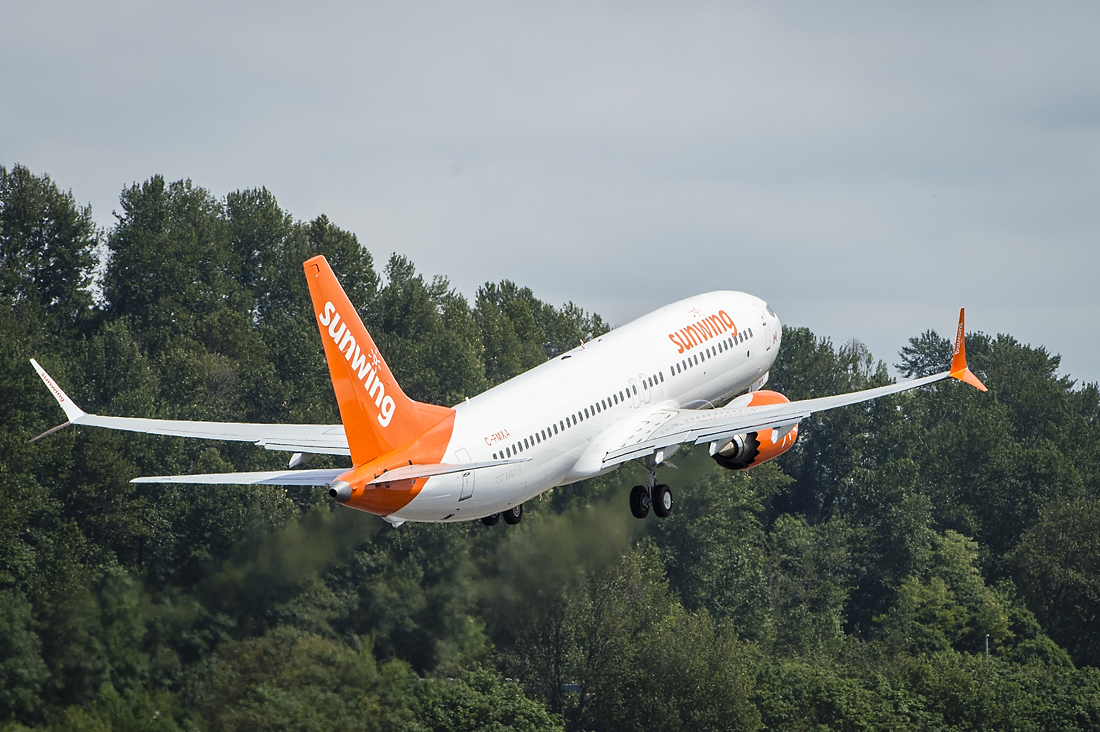Estimated reading time 23 minutes, 26 seconds.
When Piyush Gandhi was vice-president of Flight Operations at Porter Airlines, he used to advise pilots not to take a job with a charter airline.
Now, he’s eating his words.

Last November, after almost 12 years with Porter, Gandhi made the jump to Sunwing Airlines, and he hasn’t looked back since. With the same title he had at Porter, Gandhi is enthusiastic about this chance to learn how a charter airline operates.
“I find it very exciting,” he told Skies. “This airline is a very unique operation. I’ve done the OEM side [at Bombardier], the scheduled airline side, and now I can explore the charter airline side.”
Gandhi oversees Sunwing’s safety department and the operations control centre, which includes crew scheduling and crew planning, as well as the airline’s 400-plus pilots and the training administration division.
With around 2,600 employees in Canada, the airline is a branch of Sunwing Travel Group, a vertically-integrated behemoth that generates over $2 billion in annual revenue and is the largest tour operator in North America.
Along with the airline, the group also includes three tour operators, two travel retailers, a hotel division offering more than 14,000 rooms, a vacation club, and a destination management company. It employs close to 20,000 people worldwide.
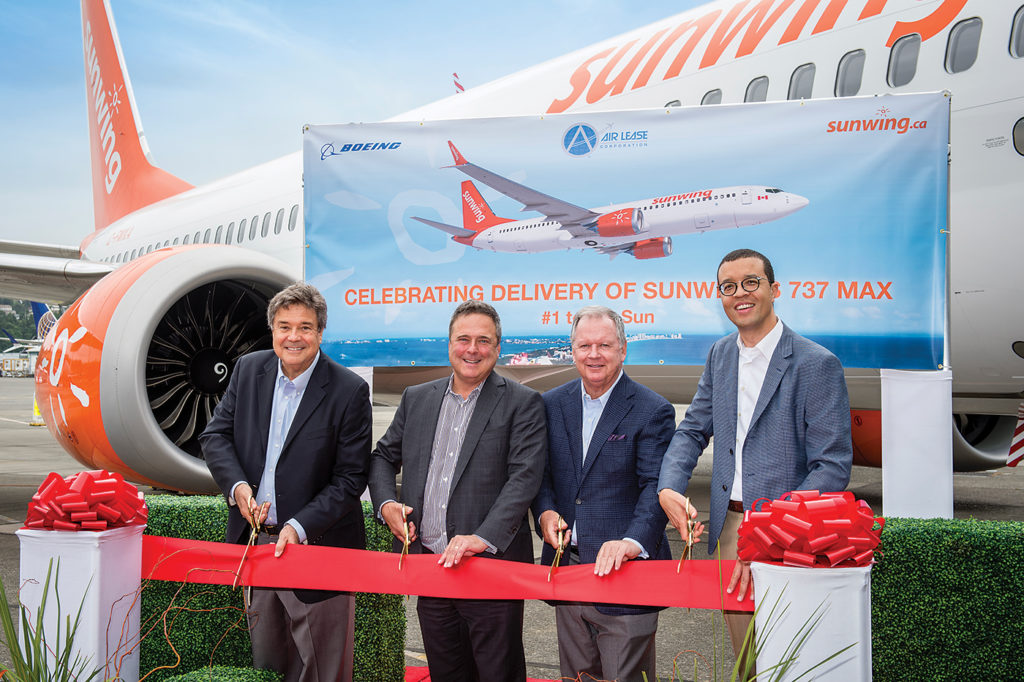
Originally started by father and son entrepreneurs Colin and Stephen Hunter–whose family still owns 51 per cent of the company–Sunwing Travel Group’s 49-per-cent minority shareholder is Hanover, Germany-based Tui Group, the world’s biggest travel and tourism organization.
“Certainly, in North America, we’re unique in what we do,” said Mark Williams, president of Sunwing Airlines. “We’re the only company that’s got that much vertical integration, which includes the hotel group as well as the rest of the businesses. But it’s not uncommon in Europe for companies to be that integrated; in fact, Tui is vertically integrated in the same way.”
Tui bought its stake in Sunwing in 2010, but the Canadian airline’s connection to Europe predates that agreement. In fact, that connection is what has allowed Sunwing Airlines to thrive since its first flight in 2005.
With its seats sold by the travel group, the key to the airline’s success is its seasonal operational model–a formula that allows it to bulk up in the busy winter travel season while leaning out in the summer.
“If you look at the business in Canada, in the markets we’re in, it’s about 70 per cent winter and 30 per cent summer,” explained Williams. “The airplanes are really expensive assets, say roughly $50 million dollars U.S. each. And if you have enough capacity in the winter time, you have way too much in the summer.
“For us, the only way to make that business work was to find people in Europe with a counter-seasonal business that would be interested in swapping assets back and forth.”
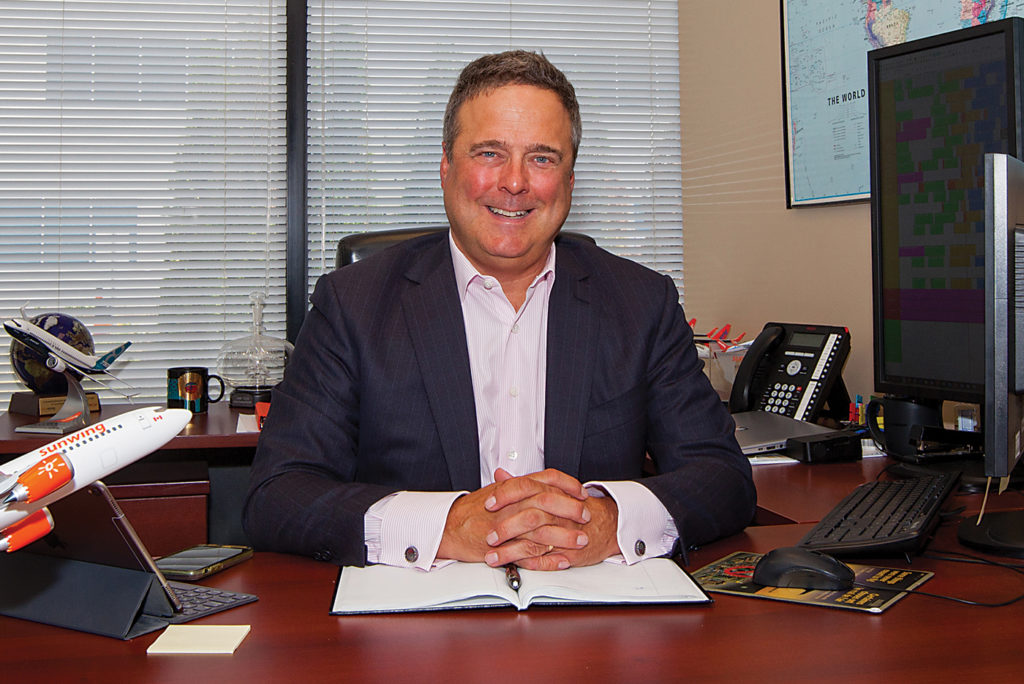
Last winter, Sunwing Airlines operated 40 airplanes out of 33 Canadian airports–ranging from Vancouver, B.C. to tiny Deer Lake, N.L.–flying to a total of 35 destinations in the U.S., Caribbean, Mexico and Central America.
By the time spring was in the air, the airline was well on its way to thinning out the Canadian fleet to just nine aircraft, all of them Boeing 737-800 NGs in a 189-seat configuration. The remainder of the fleet was transferred to Tui and Travel Service Airline in Europe for the summer season.
“If you look at what Canadians want to do in the summertime, they fly domestic, to the U.S., to Europe and to the Caribbean and Mexico,” said Williams. “We don’t do the European bit, but we do run a small domestic air-only program in the summer. And the big destinations in the Caribbean for us, we do those on a year-round basis. We focus on the big cities where there’s still demand, and send the rest of the planes to Europe.”
It’s a complicated dance that sees both airplanes and crews shuffle between Sunwing’s permanent bases in Toronto and Montreal (along with its four winter locations in Vancouver, Calgary, Winnipeg and Quebec City), and the airline’s seven European bases. Those include Dublin and Belfast in Ireland; Leeds and Norwich in England; Amsterdam, Netherlands; and Warsaw and Katowice in Poland.
As the temperatures begin to drop in Canada, Sunwing’s aircraft roster will start growing once again. For the 2018-2019 winter season, the airline will operate 43 aircraft, with demand driven by the tour company’s projections.

Each time an aircraft is transferred for the season, it is de-registered and re-registered in its new “home” country. The process creates a mountain of paperwork and heavy logistical demands on Sunwing’s maintenance department, which oversees the process.
And that’s just for the aircraft. Imagine the complications of transferring pilots overseas for the summer, too.
“We have 280 or so pilots moving around at various points–and each one of them has individual needs,” said Gandhi.
Twenty-seven pilots called the Amsterdam base home for the summer of 2018, all of them staying in a group of company cottages, many of them with their families.
“It’s a real community. Kids have grown up spending summers in Europe. The company pays for all of that travel and even a return trip in the middle of the summer,” said Gandhi. “It’s a way of life. For some people, it doesn’t work, so they can stay in Canada and keep operating from there.”
But he said the opportunity for an overseas deployment is one of the perks of working at Sunwing.
“We’re going with this mantra of ‘choose your lifestyle’ when you come to Sunwing. You could do a three-month deployment, a six-month deployment, or even a short-term two-week deployment to cover for someone.”
Entrepreneurial culture
Largely due to its seasonal model, Sunwing Airlines is by nature a nimble operator. While its business plan responds to the changing needs of the tour operator and hotel group, president Mark Williams himself is a man of action–a quality he instilled in the airline he launched 13 years ago.
Just before Sunwing Airlines was born, its harried leader found himself speeding along Highway 409.
Like an expectant father racing to the hospital, Williams was enroute from the Transport Canada offices at 4900 Yonge Street in North York to Sunwing’s office near Pearson airport. A missing certificate of airworthiness (C of A) had necessitated an 11th hour visit to the regulator.
Without that paper, the airline’s first sold-out flight–Toronto to Santiago de Cuba–would not get off the ground on Nov. 17, 2005.
“So I got it; but the irony is, when I got back to the office, they had found the faxed C of A! So I didn’t have to do it after all.”
Williams raced back to Pearson at 6 a.m. the next day.
“We had cake at the airport; we had a band there. I got my wife and children passes so they could be there for the first flight. We were handing out cake to everybody. We had little chocolate airplanes we gave out to the passengers.”

Williams said that first flight also marked the beginning of Sunwing’s signature sparkling wine “cheers to your vacation” service–a perk that passengers enjoy to this day.
And while that inaugural trip didn’t exactly go off without a hitch, it was certainly the first of many examples illustrating the nimbleness that is a characteristic of Sunwing Airlines.
“We still have a real entrepreneurial culture here,” said Williams. “We don’t have a lot of layers of management or decision-making, and I think that’s been one of our strengths. And so when we decide to move in a different direction, we don’t have to sit through a bunch of committees or analysis in order to make a decision. We focus on what’s important for the customer and how quickly we can make things happen, and then we just get it done.”
Making sound business decisions on the fly is a hallmark of the airline. One day, Marcella Howley, vice-president of Inflight Operations, made an offhand remark to Stephen Hunter, CEO and president of Sunwing Travel Group, that they needed a chef to help them design their on-board menu.
“He came back to me and said, ‘What about a celebrity chef?’ So I think we’re probably one of the first airlines in Canada to bring a celebrity chef on board. We’ve been working closely with Lynn Crawford of The Food Network since October 2016,” said Howley, who is responsible for the people, products and service delivered in the cabins of Sunwing’s 22,500 annual flights.
She said the airline was also the first to sell excursions on board, which has been a “huge success,” with other operators following suit.
From the Kidcations backpacks that keep young travellers busy to Sunwing’s signature sparkling wine toast, Howley said her well-trained team of more than 1,000 cabin crew members delivers an unforgettable vacation experience.
“I get the survey results on a weekly basis. The friendliness of our flight attendants is our number one ranking, and I’m very proud of that.”
Searching for savings
In the airline business, costs are the chief concern–and keeping them in check is the reason why many airlines are working to hone efficiencies. Every little bit counts, and it’s sometimes surprising where savings can be found.
“The cost aspect is so important to the overall price of the package for our customers,” said Williams. “So there’s a constant flow of initiatives in every area of the company, looking for cost cutting opportunities and enhancements to the business.”
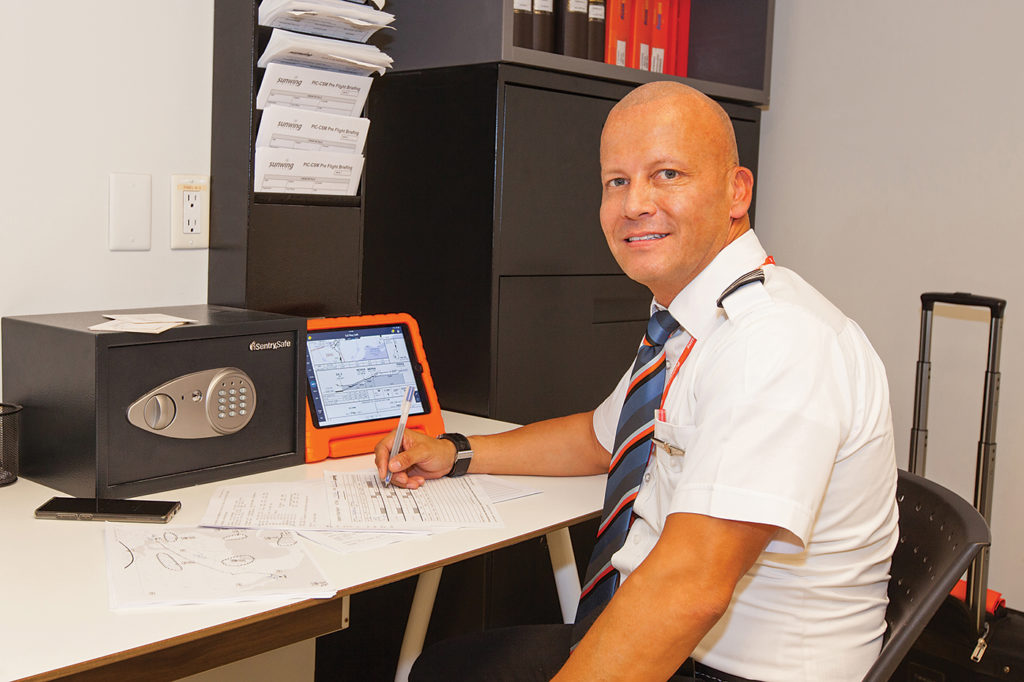
Capt Jose Moreno has been with Sunwing for 12 years. He served in the Royal Canadian Air Force before joining the airline, as many of its pilots did. Andy Cline Photo
He said Sunwing can impact the amount of fuel it burns by operating its aircraft more efficiently. That may include flying different approaches, implementing single-engine taxiing on the ramp, or even an engine washing program.
To Williams, there is no big home run in any one area–but they all add up.
“Here’s a great example: We fly, say, 3.4 million passenger segments annually, so maybe almost two million roundtrip passengers. So if we can save 50 cents on our onboard product, when it comes to finding different suppliers, that’s a million bucks. So we look at that in every aspect of what we do.”
Gandhi added that sometimes Sunwing will tanker fuel to save money. “Fuel that may cost so many dollars in Toronto through a fuel consortium may cost double that in Cuba. So we carry extra fuel out of Toronto so we don’t take on as much in Cuba.”
Saving fuel is one of the surest ways to cut operational costs.
There’s no doubt that fuel efficiency was one of the biggest drivers that led Sunwing to begin transitioning its fleet from the Boeing 737-800 NG to the 737 MAX 8.
On May 25, 2018, about 40 Sunwing employees applauded on the tarmac outside the Boeing delivery centre in Seattle, Wash., as Williams officially took delivery of the airline’s first MAX 8. That plane is the first of six scheduled for delivery by the end of 2019, and it was followed in just a few days by a second jet. Four more will be coming next year.
The new aircraft represent a real opportunity for Sunwing. New CFM LEAP-1B engines, advanced technology winglets and other aerodynamic improvements combine to make the MAX aircraft 14 per cent more fuel efficient than the older NG models currently operated by the airline.

Sunwing’s first MAX 8 touched down in Toronto late on May 25. Bright and early the next morning, it was off again on its first revenue flight.
Williams said the new aircraft are performing as advertised. The airline has been using the less busy summer season to ensure infrastructure and support for the MAX 8 are in place prior to the winter travel peak.
“The dispatch reliability on the plane so far has been excellent. We target a 99 per cent maintenance dispatch reliability, and we’re there already, and the fuel burn is as advertised. We’re seeing a 14 to 15 per cent fuel reduction versus the 737-800 NG.”
He added that the goal is to deploy the planes from Western Canada into the Eastern Caribbean, flights where in addition to the fuel burn savings, the airline can realize about 500 miles of additional range. That will open up new destinations, such as Vancouver to Panama or Costa Rica.
The load restrictions that had to be respected with the NG models are now almost non-existent.
“The highest load restricted flight we have out of Vancouver, with the plane having 189 seats, we fly at 155,” said Williams. “We have a fairly significant number of load-restricted flights from Western Canada, and in almost every case with the routes we’re flying now, we can reduce the load restriction completely, so we can sell it to 189.”
Sunwing leases all its aircraft, which Williams said allows the airline to upgrade its fleet more easily. When NG leases come due, he said Sunwing plans to replace them with the MAX.
Future forward
There’s no denying the impact of technology on every facet of our lives, so it’s no surprise that Sunwing is looking for ways to harness the power of instant customer communication.
“There’s a real opportunity for us to be more efficient in getting information out to people through phones and apps, about changes in flight times or minor delays or whatever,” said Williams.
New technology is also making inroads on the flight deck.
Capt John Hudson, Sunwing’s fleet manager, keeps a keen eye on the latest trends. There are two that he thinks will be big for the airline: connecting the pilots’ electronic flight bags (EFBs) to the airplane, and implementing domestic controller-pilot data link communications (CPDLC).
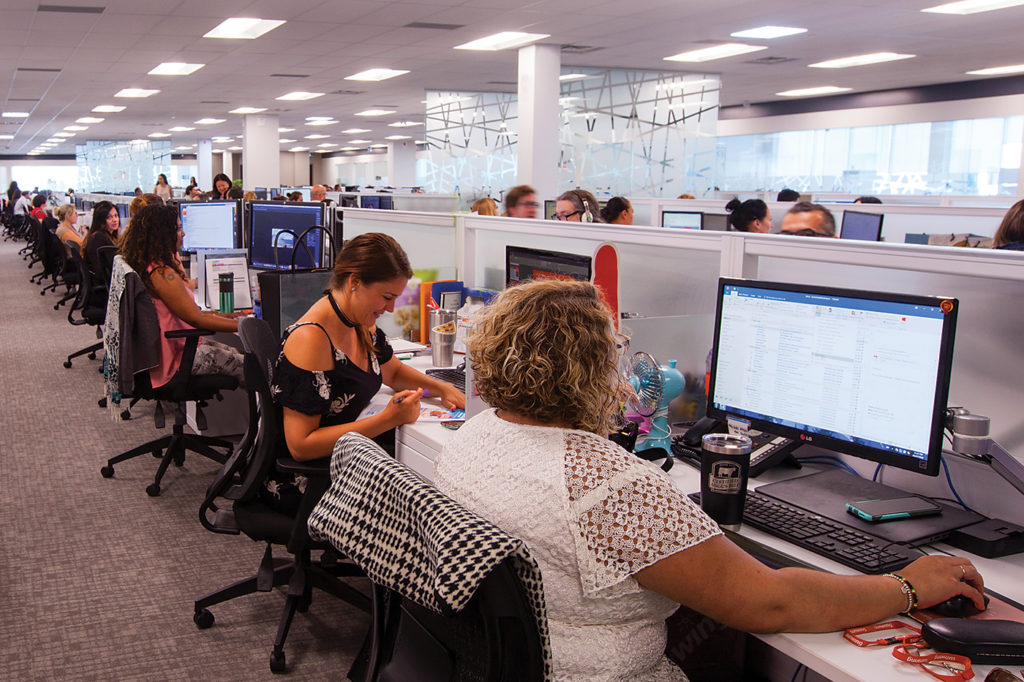
In the first case, Hudson was involved in rolling out personal iPads to each company pilot earlier this year. The devices employ Boeing’s Jeppesen Aviator software, an all-encompassing program that brings information from stand-alone EFB apps into one easy-to-use dashboard. Pilots can easily reference charts, flight briefings, performance data, weather, and more.
Hudson believes the data-driven approach inherent in the MAX 8 will open up exciting new possibilities for capturing and using important aircraft-generated information.
“There’s going to be connectivity coming in the future between the EFB and the airplane, which then leads us to ATC [air traffic control] and the airplane and your EFB. So those three items will all be connected,” said Hudson.
With datalink messaging taking over from traditional voice communications–and text messaging between pilots and ATC becoming increasingly popular–Hudson is also focused on streamlining interactions between the flight deck and air traffic controllers.
“We do our ATC clearances through ACARS [aircraft communications addressing and reporting system] right now, through the pre-departure clearance (PDC) program. So wherever we go, whenever we can, we use PDC. So we don’t have to talk.”
The pilot predicament
Like most other commercial operators in North America, Sunwing is feeling the pinch of the pilot shortage.
As a mid-tier charter carrier that sometimes loses pilots to scheduled airlines, it could see a labour shortage coming down the line–so four years ago, the company took steps to create its own solution.
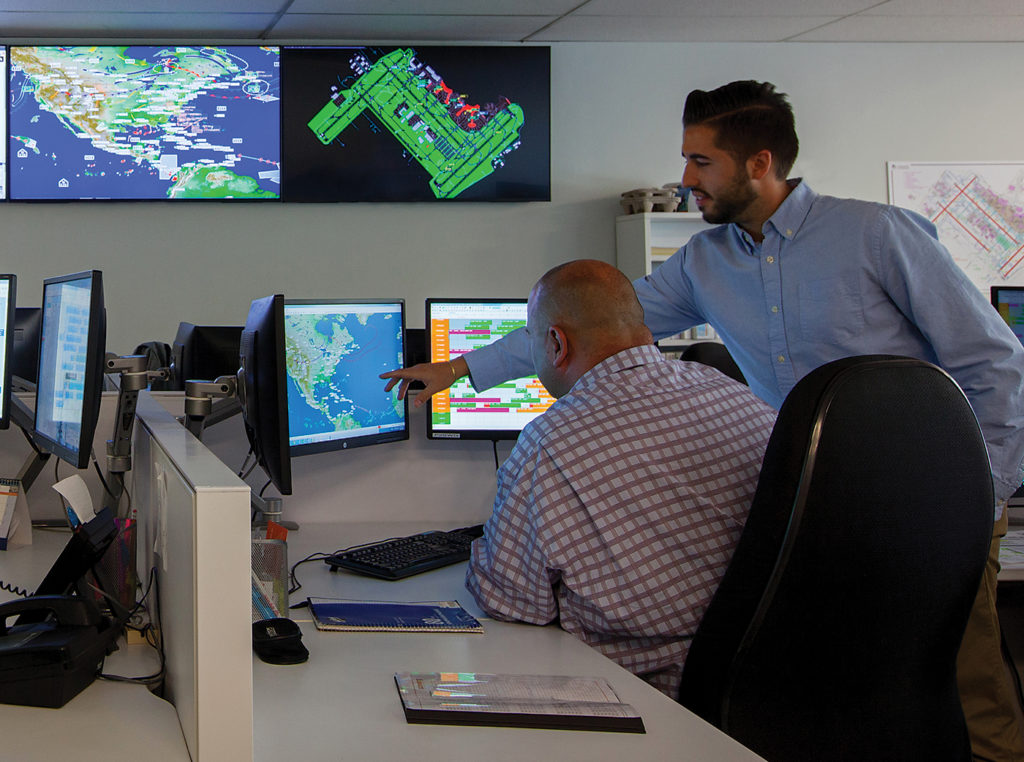
In partnership with the aviation programs at Seneca College in Peterborough, Ont., and the University of Waterloo (where students train at Waterloo Wellington Flight Centre in Breslau, Ont.), the airline interviews top students recommended by the schools and offers selected candidates a first officer position.
The program is overseen by Hudson, who happens to be a graduate of both the University of Waterloo and Seneca College’s aviation program. He said Sunwing put the onus on the schools to become familiar with the airline’s unique seasonal operating model and present students who they felt would be the best fit.
The airline’s cadet program started small, with six cadets in the first year, then four last year. In 2018, Hudson said Sunwing plans to hire 14 new graduates.
“We have more confidence in the program. We’ve looked at it; we’ve done all the risk assessments. Now everything’s coming to fruition and we haven’t seen any markers that show us that we should keep the number down to anything less than that.”
Sunwing cadets are streamed through a different training program than other hires with more experience.
“The risk assessment drove the changes to our normal training program,” explained Hudson. “What it identified was that they’re really good learners. They just came through a four-year degree. And so through academic and simulator training phases they’re really good. Where they needed to work the hardest was in a crew environment, but both schools have some crew training now baked into their programs, which really helps.”
To ensure cadets get off to a good start, Sunwing assigns each new hire to work with a dedicated training captain.
“For approximately their first 50 hours or so, they just have one training pilot, which really helps for continuity. Then we release them to the training pilot group [a group of experienced pilots who volunteered to work with the cadets], and then the cadet is exposed to multiple different trainers, which is normal during line indoctrination training.”

Hudson said a normal line indoc for a 3,000-hour new hire pilot is 75 hours at most. Cadets, on the other hand, get around 200 hours. They are line checked at 75 hours and then continue to fly under the supervision of a training pilot. During this time, they are also meeting Sunwing’s “geographic” requirement–in other words, a pilot must experience specific airports that present unique challenges to flight crew. That includes Mexico’s mountainous west coast, Cancun’s high density traffic, and the Caribbean’s unique flight rules.
After 200 hours, cadets are released to the line. Six months after their pilot proficiency check (PPC), they’re back in the simulator for their first recurrent training session, which Hudson said is a good opportunity to check their progress.
Sunwing pilots log about 800 hours of flying annually. The airline expects to employ 430 pilots by January, adding about 40 to its current roster to meet expected winter demand. (Fourteen of those 30 will be new cadets.)
While Sunwing works to address the pilot shortage, the same difficulties are not felt on the cabin crew side of the operation. Marcella Howley said she expects to hire about 200 new crew members this season. They’ll be joining more than a thousand colleagues who are spread across the county in eight bases, from Vancouver to Halifax.
On the regulatory horizon
In the midst of the air crew shortage, Sunwing–like all other Canadian operators–is keeping a close eye on the proposed changes to pilot flight and duty time regulations.
Transport Minister Marc Garneau is currently overseeing what he called science-based changes that would see a pilot’s duty day reduced to between nine and 13 hours–depending on what time of day they start, as well as how many times they take off and land.

For Sunwing, the proposed changes would have a big impact on operations.
Gandhi provided an example: “We currently fly a standard pairing of Toronto to Cancun. In the new regs, duty time is impacted by the time of day the pairing starts. Our pairing starts at 4:45 a.m. for a 6:45 a.m. departure.
“You would take off from Toronto, go to Cancun, have a one-hour turnaround and come back. That meets the regulations today because it ends up being around 12 hours of duty. But under the new regs, that duty time is reduced because of the time of day the pairing starts. That means we’ll have to put another crew in Cancun and swap the crews there. So you are basically doubling the requirement of pilots for that trip.”
Gandhi estimated that Sunwing would require about 30 per cent more pilots to comply with the new regulations, which are currently in the final stages of approval.
Williams added that Sunwing is certainly in favour of examining pilot fatigue and its impact on safety. However, he believes Canada already sets a very high standard.
“While I’m saying we should look at fatigue and it’s important to always improve, there’s no real indication that it’s a significant problem at the moment,” he told Skies.
“That doesn’t mean we shouldn’t be looking at continuing to get better. But my concern is that the regulations will require a significant number of additional pilots within the system overall. We’re already experiencing a pilot shortage in Canada even before the regulations come in, which will likely make it worse.”
He believes the resulting scramble to hire even more pilots will ultimately drive the collective pilot experience level down, as those with fewer hours are fast-tracked through the system.

“I think in this case the unintended consequence, which will be lowering the experience levels within the industry overall, is a bigger problem than the fatigue issue they’re trying to fix.”
Also on the regulatory horizon is the coming passenger rights bill, which is expected to change the framework of air carriers’ obligations to the travelling public.
In May, the federal government passed Bill C-49, the Transportation Modernization Act. It’s a wide-ranging piece of legislation that includes, among other things, a requirement for the Canadian Transportation Agency (CTA) to introduce new regulations governing passengers’ rights to recourse for a host of issues, including flight delays and cancellations, lost luggage, overbooking and tarmac delays.
A series of cross-country public consultations took place this summer, and the CTA continues to accept input from Canadians until Aug. 28. At that point, the agency will assemble a list of recommendations for the new passenger rights framework and will submit it for a vote in the House of Commons.
Air carriers across the country are watching this process closely.
While all of them have been under the service microscope at one time or another, Sunwing was front and centre in April 2018. A series of incidents and subsequent passenger complaints prompted an ongoing CTA review of the airline’s flights through Toronto and Montreal from April 14 to 18, 2018.
During that time, Toronto was in the grip of an ice storm and Swissport, the company that handles Sunwing’s baggage, was short-staffed.
Sunwing has worked closely with the CTA during its investigation.
On July 19, the CTA told Skies the period for submissions from any affected parties closed on May 31. The inquiry officer’s report is currently being drafted and is expected to be completed by the end of August, at which point it will be submitted to the CTA for consideration.
“While the major issue around the ice storm delays was staffing levels on the ramp at Swissport, we did not perform up to the high expectations we set for ourselves,” said Gandhi. “We’ve taken our lumps for that situation and we’ll be a better airline as a result. We’re really focused on it; we have established working groups now to look at how to improve various elements of customer service.”
“The Sunwing way”
For his part, Williams is proud of Sunwing–the airline he started and still considers his baby–and is urging his staff to strive for constant improvement.
“Obviously, we’re always interested in improving the product,” he said. “My challenge to my staff is that we can always do better. Let’s raise the bar even more; let’s improve on our performance even more. Let’s get the customer satisfaction ratings up even higher. And, you know, that’s the way the airline can support the [travel] group.”
While there are countless examples of satisfied passengers, their stories do not usually make the mainstream news. A notable exception was the time Sunwing arranged for a couple to be married at Calgary airport’s new International Terminal in 2017–a memorable way to start their honeymoon.
In the last year, Howley said she’s worked with four men to arrange on-board proposals. She said in every case, the crew has worked to make it a special experience.
“For one couple they participated in a game where each had to answer travel questions for prizes,” she recalled. “As the entire cabin watched this onboard game show, we announced that there was only one remaining question–but her boyfriend needed to ask it. To her surprise, he got down on one knee and proposed. We scheduled the sparkling wine toast to follow. These were memorable flights for our passengers and crew.”
As summer draws to a close and temperatures begin to fall, Sunwing’s seasonal model will ramp up for another busy winter of flying sun-starved Canadians to all points south. Along the way, the airline will be focusing on innovation, cost control, new markets and product improvements.
That’s just the Sunwing way.
